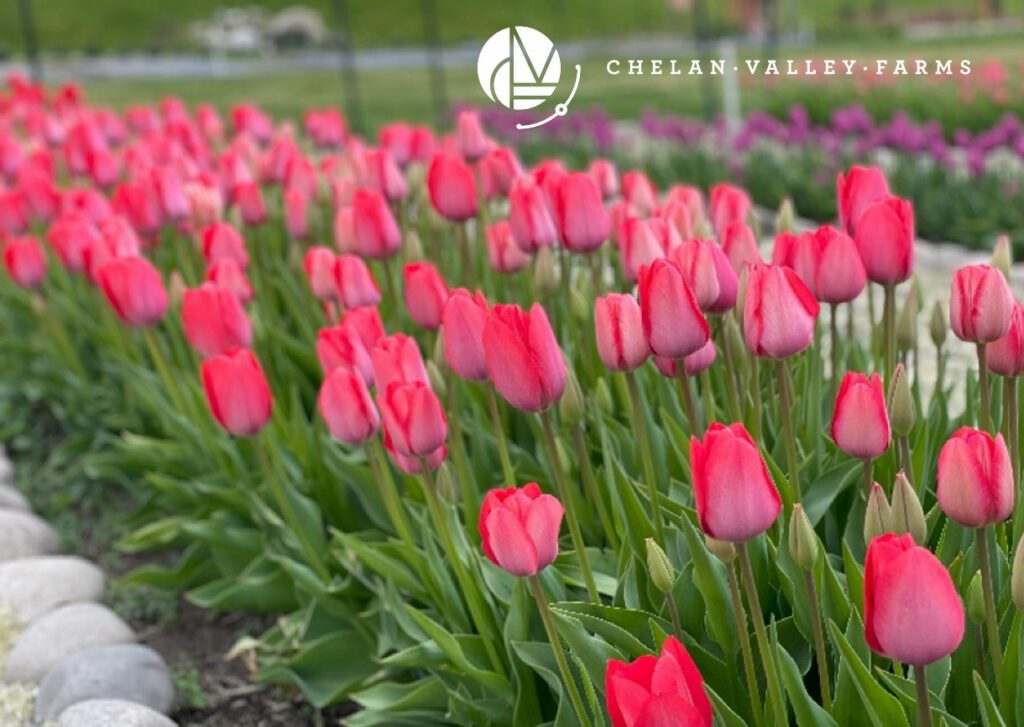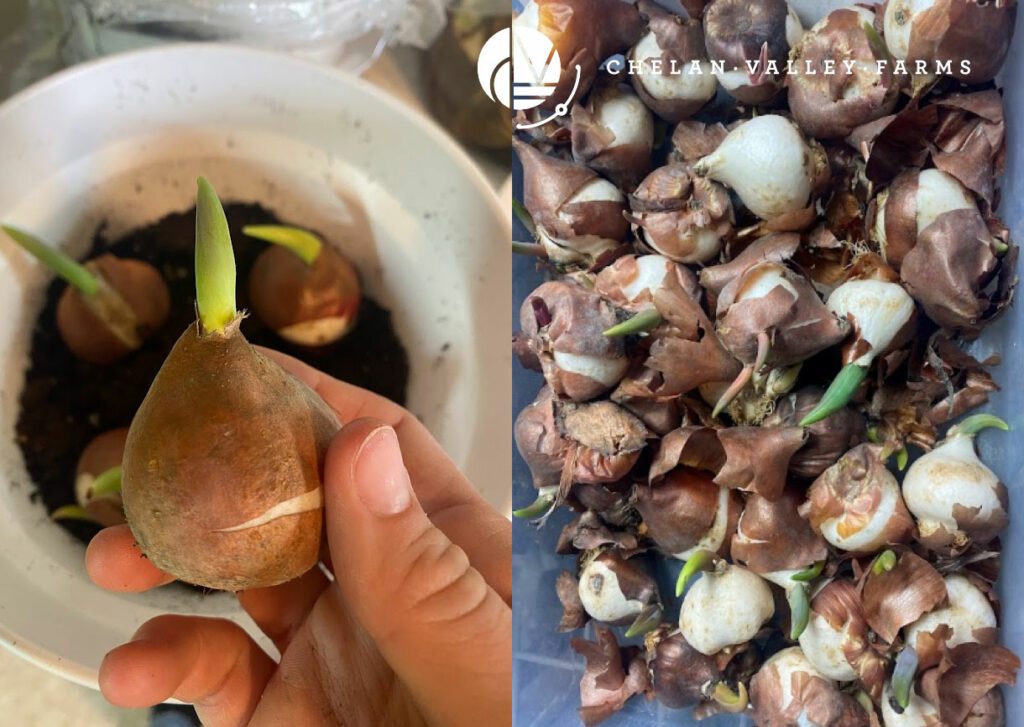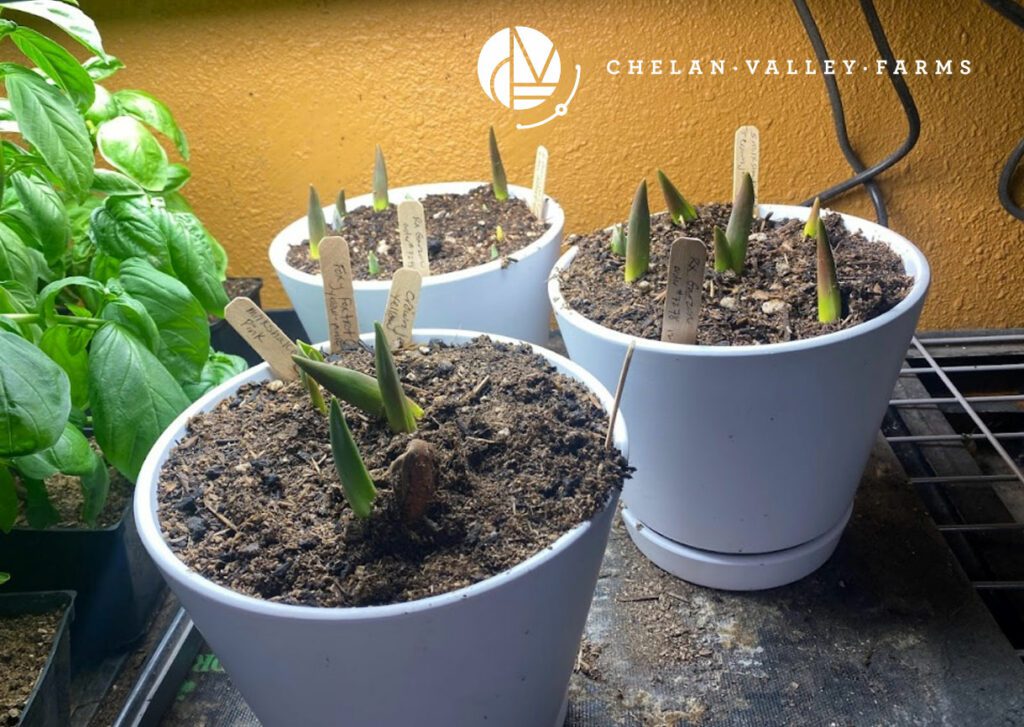Sourcing, Growing and a History of Tulips
A renowned staple of Spring is the arrival of new things. Though the year in our calendar begins on January first, Spring is what truly says, “Happy New Year!” for me. The snow begins melting, the days grow longer, and the world wakes up.

At Chelan Valley Farms, Tulips make their Spring debut in brilliant colors of red, purple, yellow and orange, welcoming in the new year with vitality and beauty. I have grown in my love of Tulips and working with Tulips and learning about them has given me newfound appreciation for them.

Tulips – A Quick History
I have always loved wildflowers so when I learned that modern Tulips were in fact, originally a wildflower, I was shocked. Tulips were first discovered growing in the mountains of 16th century Kazakhstan. The Tulips we see today are the product of four centuries of slowly breeding them to perfection. Tulips were brought to Turkey after a part of Kazakhstan was conquered by the Ottoman Empire. They were planted in the gardens of powerful and wealthy people. With this they quickly became a staple of wealth which eventually led to the Dutch Society Tulip Mania in the 17th century. Tulips with bi-coloring in the 17th century were highly sought after. Artists of Dutch society painted still life’s of these unique blooms referring to them as Rembrandt Tulips though the Artist Rembrandt did not himself paint floral paintings. Rather, the city of Leidan, where Rembrandt was born, was the first location in Holland where Tulips were grown. Interestingly, these rare colorful blooms were the result of a viral infection spread by Aphids. Unlike those 17th century tulips, the “flaming” varieties we see today are healthy and have been specifically bred to produce multicolored blooms.

Tulips discovered in Kazakhstan by Ottoman Empire in 16th century- Brought to Turkey in 16th century- Dutch society Tulip Craze in 17th century.
For a more in-depth history on Tulips, check out History of the Tulip and What Are Rembrandt Tulips!
Sourcing & Planting in the Fall
Unsurprisingly, one of the best places to source Tulips is from Holland. We ordered our 30,000 Tulips this year from Westerbeek Bulb Company. They are ideal for sourcing when it comes to large orders. For smaller scale orders- sites like Holland Bulb Farms and Eden Brothers are great for sourcing. Keep in mind that Tulip bulbs are typically something you want to purchase in the Fall since they require a lengthy cooling period. Last November, we planted around 29,000 of our Westerbeek bulbs and set aside approximately 1000 bulbs for winter force blooming. Last fall we aimed to get the bulbs in the ground earlier than the year prior and it turned out for the best. Two years running, we completed getting the bulbs in the ground and insulating them the day before the first snow. This year they were tucked snug away by November 5th and November 6th was a snow day! Tulips require 12-14 weeks of temperatures under 55 degrees Fahrenheit for them to wake up and grow in the Spring. (Select Tulips varieties may require 16-18 weeks of cold.) Temperatures under 20 degrees Fahrenheit may kill bulbs so living on this side of the mountain where we often have below freezing temperatures, insulating the bulbs is important. We planted the bulbs approximately 4-6 inches deep and covered the soil with a thick layer of straw to insulate.

Growing Care
Tulips need 55-degree Fahrenheit (or cooler) temperatures for 12-14 weeks before they will grow. Once they’re in the ground, it’s a waiting game. When temperatures begin to rise above 60 degrees, they will spring up rather quickly. After they have sprouted, bulbs take 2-3 weeks to begin blooming depending upon whether they’re an earlier or later variety and need around 6 hours of direct sunlight per day for best results. Tulips do not need to be planted in the soil in the fall for Spring blooms; find a cool area to store them away (your garage or your fridge for example) and store them away for 12-14 weeks starting from the day they were stored away.
Force Blooming
At Chelan Valley Farms, we have been in the process of starting force blooms for Valentine’s Day and beyond. This has been a fun learning curve and with it being our first year of experimenting with this, we weren’t positive of what the results would be, but the Tulips are sprouting and growing happily! To force bloom Tulips, we plant them two layers deep in each pot for a longer bloom period. Tulip bulbs have a flatter side and a rounder side; the flat side is where the leaf of the tulip will grow from, fellow gardeners suggest that planting the flat side against the edge of the pot will make for a beautiful presentation at full bloom. After planting, we water them and put them under artificial light and on heat mats. We have noticed that after Tulips have gotten a good start, they grow better removed from the heat mats; Tulips need light but too much heat appears to stunt growth.


For more information about force blooming, check out these videos on YouTube- Forcing Tulips to bloom inside and How to Force Tulips Indoors. There are many ways to beginning force blooming, experiment with it and find what works best for you!
Cut Blooms & Storing Bulbs
I am looking forward to U-Pick Tulips this Spring and getting to welcome in the warm weather with everyone visiting the farm. A tip for your future Spring visit to the farm and other U-Pick Tulip locations, the best time to harvest a Tulip is when the bloom has not opened yet and once the bloom has developed more than half of it’s full color. Harvesting at this stage will ensure a longer vase life which is typically around 7-10 days. Like with other flower varieties, the best time to harvest is in the cooler hours of the day (morning/evening). Harvesting blooms in high heat will cause blooms to wilt much more quickly. To promote longevity, clean your vase before use and try to switch out the water every couple of days. Clean water with flower food will help keep flowers happy. Better Homes and Gardens has some excellent tips for harvesting Tulips. Tulips, Dahlias and other flowers that grow from bulbs/tubers are truly the gifts that keep on giving. If Tulips are not harvested for cut flowers but instead, stay in your garden to be enjoyed outside, they can easily be replanted in the next growing season. To preserve bulbs for the following year, let the blooms flower and fade. Once the foliage of your Tulip has withered, dig up the bulb. Clean off the soil and allow them to dry. Store the bulbs in a dark/cool space in a paper bag or netting to avoid rot. Molding and rot will occur if the environment is too humid. To take it a step further and propagate your Tulips- if the parent bulb (the original bulb that was planted) has sprouted offsets (new bulbs) these can be split from the parent bulb and stored with your other bulbs. According to The Dutch Grown Blog, these offsets may not bloom the following Spring and might need to grow for two seasons before they produce blooms. Note that you will probably find more success propagating Tulips and replanting last season’s bulbs if they were grown in your garden rather than in pots.

Tulip Festivals in the Pacific Northwest
To see some color this upcoming Spring, some excellent festivals to check out are Skagit Valley Tulip Festival, Wooden Shoe Tulip Festival, and Chilliwack Tulip Festival.
Most of us have heard of Skagit Valley Tulip Festival. This festival is a staple of Washington state and is located on the western side of Washington. Also, throughout the month of April they have loads of events going on! Located in Oregon with 40 acres of tulips and 200 acres of outdoor space and activities, Wooden Shoe Tulip Festival is another spot worth checking out this Spring season. For folks heading North this Spring, Chilliwack Tulip Festival is the largest Tulip Festival in BC with 20 acres of blooms.
Having all these incredible festivals and gardeners on every side of us makes me feel so fortunate to live somewhere where so many flower varieties grow so beautifully and where people cultivate the land. Nowhere else is quite like the Pacific Northwest!
We look forward to seeing ya’ll this weekend for your Valentine’s tulip pickup. Happy Valentine’s!
Get Directions to Chelan Valley Farms



